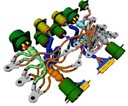Linius Releases EMbassy 2.5 Wire Harness Design Automation Tool

Linius Technologies today began shipping v2.5 of the company's wire harness design software. In an effort to reduce time to market, increase performance, and contain costs, equipment manufacturers are using CAD systems more and more to automate machine designs. Now the difficult task of designing complex wiring systems used by modern equipment can be done using these same CAD systems. What was once a tedious, error prone manual process, can now be augmented with computers. Linius Technologies first introduced automated wiring design technology in 1999 as means to increase efficiency and lower costs. Today, a growing number of industries are finding applications for CAD wire harness design systems.
"With the new 2.5 version of EMbassy we're able to call out the loom by itself and show it on a nailboard drawing. Using different colors for the various diameters makes assembly much easier," says electrical engineer Wayne Lorenz of Nilfisk-Advance, a manufacturer of industrial floor cleaners in Minnesota. "I also like being able to embed dimensions into channels and into wires, and the clearer drawings that are produced. Another feature I like is the ability to put splices into the harness. The splice tables and spider diagrams work really well. They're nice features," he says.
At Nilfisk-Advance use of string and tape measure to approximate wire lengths, along with the manual documentation of the hundreds of parts involved in the design of wire harnesses, is a thing of the past. Using EMbassy, Nilfisk-Advance engineers are designing their wire harnesses and cable systems within the context of their 3D CAD model.
"We can now take our 3D model and bring in a list of wires from OrCAD apture," Lorenz says. "EMbassy automatically routes the wires and alculates the wire lengths. Everything is done on the computer rather than trying to guess at it. It's a real time saver, and eliminates a lot of human error," he says.

A 3D model of the completed harness can be output in either VRML or IGES for use in downstream applications.
"As a result of working closely with our customers, we have added numerous software enhancements in v2.5 that make automating the complex task of wire harness design even more compelling," says Linius CEO Tim Alibozek.
"There is no longer a logical reason for manufacturers to wait for hardware prototypes of their assemblies to be built. By computerizing this tedious, error prone operation, managers can implement more efficient processes and reduce production costs.
Automation of wire harness design will give their engineers more time to focus on optimizing the form, fit, function and quality of the design." EMbassy combines electrical connectivity with a 3D model to create an intelligent electro-mechanical design environment. Earlier versions of EMbassy enabled engineers to automate their harness designs, computerize their parts library, and create accurate manufacturing documents.
Version 2.5 gives engineers and manufacturers even more power and freedom with the following additional features:
Verification
• DRCs - User-defined, custom design rule checks
• Bend radius checking on channels - The bend radius check on individual wires has been extended to channels 2D Documentation and Manufacturing
• Not-to-scale 2D harness drawings - Provides not-to-scale drawings that allow the user to stretch or shrink individual channel segments
• Fill codes and line styles - Provides control of the display of wires and channels on the nailboard by specifying a fill code and line style
• In-line dimensioning - Enables channel dimensions to be embedded in the channel segment without any witness or extension lines
• Channel snap - Enables the user to specify a snap angle to create perfectly straight channels and exact 90s bend angles Library Management
• Reports on the library- EM~Report has been enhanced to enable the creation of configurable reports on the library part data
• Part databook - A new facility that enables the user to do keyword searches when selecting parts, wires and attached parts for placement in a design
• Library and project import/export improvements - Allows the exportation of only those parts that are used in the selected design
Design
• Graphical loom/harness coverings - A new attached part type (loom) has been defined to represent channel coverings
• Harness ID propagation - Propagates a wire's harness ID to all related components
• ASCII import of part instances - Enables the automatic placement of library parts by specifying the name, coordinates and rotation of the part
For further information on licenses, contact Linius at info@linius.com or 508.616.9300. EMbassy v2.5 prices begin at $6,000.
Edited by Stephen Heiser
